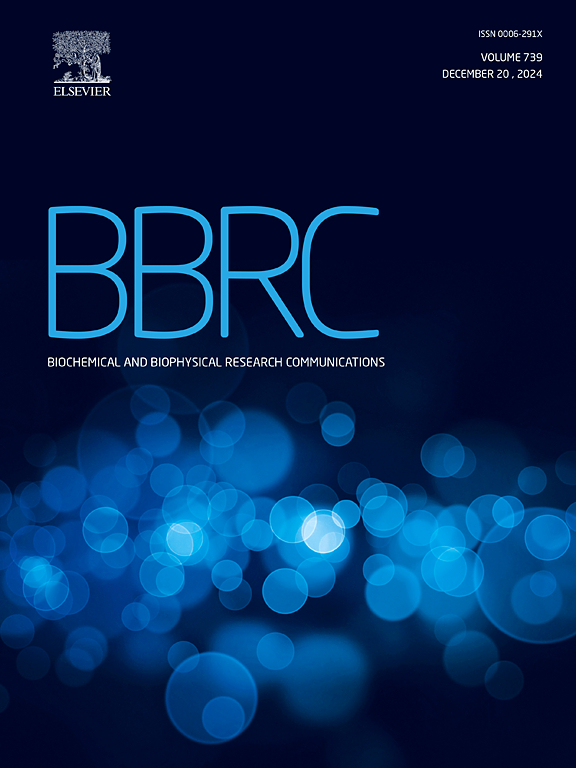Unravelling biochemical and molecular mechanism of a carboxylesterase from Dietzia kunjamensis IITR165 reveal novel activities against polyethylene terephthalate
IF 2.2
3区 生物学
Q3 BIOCHEMISTRY & MOLECULAR BIOLOGY
Biochemical and biophysical research communications
Pub Date : 2024-10-13
DOI:10.1016/j.bbrc.2024.150833
引用次数: 0
Abstract
Plastics and plasticizers accumulate in the ecological niches affecting biodiversity, and human and environmental health. Bacteria degrading polyethylene terephthalate (PET) were screened and PETases involved in PET degradation were characterized. Here, we identified a carboxylesterase Dkca1 of 48.44 kDa molecular mass from Dietzia kunjamensis IITR165 shown to degrade amorphous PET film into bis(2-hydroxyethyl) terephthalate (BHET) and terephthalic acid (TPA) formed 64.35 μM and 35.26 μM, respectively within 96 h at 37 °C as revealed by LC-MS analysis showed significant PET hydrolase activity similar to reported PETases. SEM analysis confirms the surface erosion as cavities and holes. Dkca1 also hydrolysed BHET and dibutyl phthalate (DBP) at a concentration of 1 mM within 3 h indicating its versatility. Fluorescence quenching shows Dkca1 protein has a maximum affinity (Kd) towards BHET (86.55 μM) than DBP (134.2 μM). The protein demonstrated high stability under temperatures above 40 °C and at the pH range of 6.0–9.0. Moreover, Amino acid composition showed that the Dkca1 enzyme belongs to family VII carboxylesterase containing conserved catalytic triad of Ser183-Glu289-His378 with pentapeptide motif GXSAG and an oxyanion hole H103GGG106, sharing 37.47 % and 32.44 % similarity with a PET hydrolase TfCa from Thermobifida fusca and PAE hydrolase CarEW from Bacillus sp. K91, respectively. A docking study revealed that ligand PET, BHET, and DBP showed favourable binding in the catalytic pocket of the Dkca1 protein.
揭示昆虫膳食纤维 IITR165 羧化酯酶的生物化学和分子机制,揭示其抗聚对苯二甲酸乙二醇酯的新活性
塑料和增塑剂在生态壁龛中累积,影响生物多样性以及人类和环境健康。对降解聚对苯二甲酸乙二醇酯(PET)的细菌进行了筛选,并对参与 PET 降解的 PET 酶进行了鉴定。在此,我们从 Dietzia kunjamensis IITR165 中鉴定出了一种分子质量为 48.44 kDa 的羧基酯酶 Dkca1,经 LC-MS 分析表明,该酶可在 37 °C 下 96 小时内将无定形 PET 薄膜降解为对苯二甲酸二(2-羟乙基)酯(BHET)和对苯二甲酸(TPA),生成量分别为 64.35 μM 和 35.26 μM。扫描电子显微镜(SEM)分析证实表面侵蚀为空洞和孔洞。Dkca1 还能在 3 小时内水解 1 mM 浓度的 BHET 和邻苯二甲酸二丁酯(DBP),这表明它具有多功能性。荧光淬灭表明,Dkca1 蛋白对 BHET 的亲和力(Kd)最大(86.55 μM),而对 DBP 的亲和力(Kd)最小(134.2 μM)。该蛋白质在 40 °C 以上的温度和 6.0-9.0 的 pH 值范围内表现出很高的稳定性。此外,氨基酸组成显示,Dkca1 酶属于羧基酯酶家族 VII,含有保守的催化三元组 Ser183-Glu289-His378 和五肽基序 GXSAG 以及一个氧阴离子孔 H103GGG106,分别与来自 Thermobifida fusca 的 PET水解酶 TfCa 和来自 Bacillus sp. K91 的 PAE水解酶 CarEW 有 37.47 % 和 32.44 % 的相似性。对接研究显示,配体 PET、BHET 和 DBP 在 Dkca1 蛋白质的催化口袋中显示出有利的结合。
本文章由计算机程序翻译,如有差异,请以英文原文为准。
求助全文
约1分钟内获得全文
求助全文
来源期刊
CiteScore
6.10
自引率
0.00%
发文量
1400
审稿时长
14 days
期刊介绍:
Biochemical and Biophysical Research Communications is the premier international journal devoted to the very rapid dissemination of timely and significant experimental results in diverse fields of biological research. The development of the "Breakthroughs and Views" section brings the minireview format to the journal, and issues often contain collections of special interest manuscripts. BBRC is published weekly (52 issues/year).Research Areas now include: Biochemistry; biophysics; cell biology; developmental biology; immunology
; molecular biology; neurobiology; plant biology and proteomics

 求助内容:
求助内容: 应助结果提醒方式:
应助结果提醒方式:


